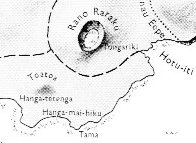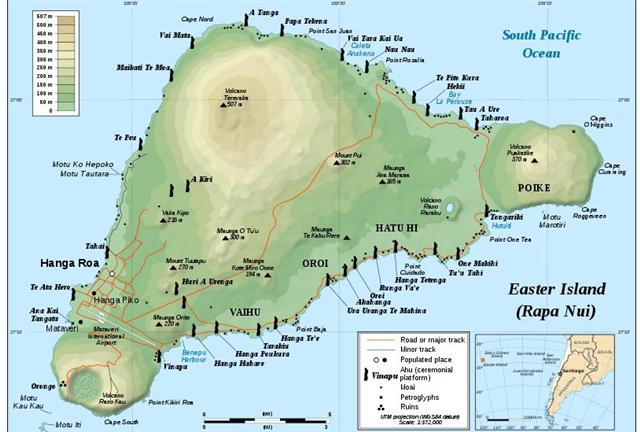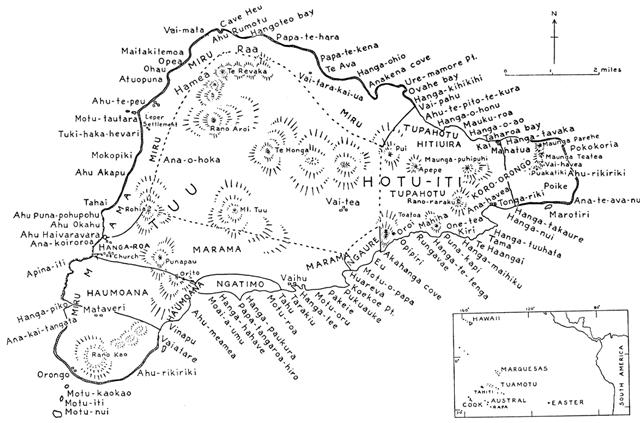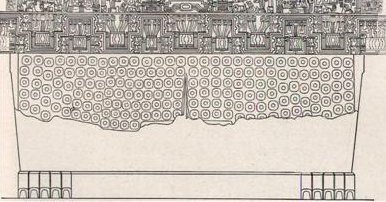The Tama station - He Ika Kino, the Bad 'Fish' - was underlined (so to say) by the dream soul who here omitted any reference to Hau Maka in Hiva:
Tama was evidently the name of a peninsula south of Rano Raraku:
And Poike One Tea is marked on modern maps as a peninsula further to the east.
On the map of Métraux it looks as if Tama could be the whole great peninsula ending at the point he named Hanga-tuuhata.
Perhaps this prominent point was referred to in the name Tama He Ika Kino He Ihu Roroa. Ihu. 1. Nose; ihu more, snub nose, snub-nosed person. 2. Ihuihu cape, reef; ihuihu - many reefs, dangerous for boats. 3. Ihu moko, to die out (a family of which remains only one male without sons); koro hakamao te mate o te mahigo, he-toe e-tahi tagata nó, ina aana hakaara, koîa te me'e e-kî-nei: ku-moko-á te ihu o te mahigo, when the members of family have died and there remains only one man who has no offspring, we say: ku-moko-á te ihu o te mahigo. To disappear (of a tradition, a custom), me'e ihu moko o te tagata o te kaiga nei, he êi, the êi is a custom no longer in use among the people of this island. 4. Eldest child; first-born; term used alone or in conjunction with atariki. Vanaga. 1. Nose, snout, cape T (iju G). Po ihuihu, prow of a canoe. P Pau.: ihu, nose. Mgv.: ihu, nose; mataihu, cape, promontory. Mq., Ta.: ihu, nose, beak, bowsprit. Ihupagaha, ihupiro, to rap on the nose, to snuffle. 2. Mgv.: One who dives deep. Ta.: ihu, to dive. Churchill. Sa.: isu, nose, snout, bill. Fu., Fakaafo, Aniwa, Manahiki: isu, the nose. Nuguria; kaisu, id. Fotuna: eisu, id. Moiki: ishu, id. To., Niuē, Uvea, Ma., Ta., Ha., Mq., Mgv., Pau., Rapanui, Tongareva, Nukuoro: ihu, id. Rarotonga: putaiu, id. Vaté: tus, id. Viti: uthu, nose. Rotumā: isu, id. ... usu and ngusu ... serve as transition forms, usu pointing to isu the nose in Polynesia and ngusu to ngutu the mouth, which is very near, nearer yet when we bear in mind that ngutu the mouth is snout as well and that isu the nose is snout too ... Churchill 2. And as to Hanga-tuuhata the part carrying the basic meaning seems to be hata: Hata. 1. Table, bureau. P Pau.: afata, a chest, box. Mgv.: avata, a box, case, trunk, coffin. Mq.: fata, hata, a piece of wood with several branches serving as a rack, space, to ramify, to branch; fataá, hataá, stage, step, shelf. Ta.: fata, scaffold, altar. 2. Hakahata, to disjoint; hakahatahata, to loosen, to stretch. P Pau.: vata, an interval, interstice. Mgv.: kohata, the space between two boards, to be badly joined; akakohata, to leave a space between two bodies badly joined; hakahata, to be large, broad, wide, spacious, far off. Mq.: hatahata, fatafata, having chinks, not tightly closed, disjointed. Ta.: fatafata, open. 3. Hatahata, calm, loose, prolix, vast. Mgv.: hatahara, broad, wide, spacious, at one's ease. Ta.: fatafata, free from care. Mq.: hatahata, empty, open. 4. Hatahata, tube, pipe, funnel. Churchill. Sa.: fata, a raised house in which to store yams, a shelf, a handbarrow, a bier, a litter, an altar, to carry on a litter; fatāmanu, a scaffold. To.: fata, a loft, a bier, a handbarrow, to carry on a bier; fataki, a platform. Fu.: fata, a barrow, a loft; fatataki, two sticks or canes attached to each other at each side of a house post to serve as a shelf. Niuē: fata, a cage, a handbarrow, a shelf, a stage, (sometimes) the upper story of a house. Uvea: fata, a barrow, a bier. Fotuna: fata, a stage. Ta.: fata, an altar, a scaffold, a piece of wood put up to hang baskets of food on; afata, a chest, a box, a coop, a raft, a scaffold. Pau.: fata, a heap; afata, a box, a chest. Ma.: whata, a platform or raised storehouse for food, an altar, to elevate, to support. Moriori: whata, a raft. Mq.: fata, hata, hataá, shelves. Rapanui: hata, a table. Ha.: haka, a ladder, an artificial henroost; alahaka, a ladder. Mg.: ata, a shelf; atamoa, a ladder; atarau, an altar. Mgv.: avata, a coffer, a box. Vi.: vata, a loft, a shelf; tāvata, a bier. The Samoan fata is a pair of light timbers pointed at the ends and tied across the center posts of the house, one in front, the other behind the line of posts; rolls of mats and bales of sennit may be laid across these timbers; baskets or reserved victuals may be hung on the ends. The litter and the barrow are two light poles with small slats lashed across at intervals. The Marquesan fata is a stout stem of a sapling with the stumps of several branches, a hat tree in shape, though found among a barehead folk. These illustrations are sufficient to show what is the common element in all these fata identifications, light cross-pieces spaced at intervals. With this for a primal signifaction it is easy to see how a ladder, a raft, a henroost, an altar come under the same stem for designation. Perhaps Samoan fatafata the breast obtains the name by reason of the ribs; it would be convincing were it not that the plumpness of most Samoans leaves the ribs a matter of anatomical inference. Churchill 2.
13h (197.8)
AL DAFĪRAH
(Tuft) = β Com. Ber.
(199.4)
*158.0 = *199.4 - *41.4
σ Virginis (200.4)
γ Hydrae (201.0), ι Centauri
(201.4)
Al Simāk-12 (Lofty) /
Chitra-14 (Bright One) /
Horn-1 (Crocodile) /
Sa-Sha-Shirū-20
(Virgin's Girdle) /
ANA-ROTO-3 (Middle pillar)
MIZAR =
ζ
Ursae Majoris
(202.4),
SPICA
=
α
Virginis,
ALCOR
= 80 Ursae Majoris
(202.7)
... On
the twentieth day of the
month of August ('Hora Iti')
they went to Papa O Pea.
They all went and came to
Papa O Pea, looked around in
Papa O Pea, and gave the
name 'Papa O Pea A Hau
Maka'. They stayed five days
in Papa O Pea.
On
the twenty-sixth day of the
month of August ('Hora Iti')
they went from Papa O Pea to
Ahu Akapu. They all went and
reached Ahu Akapu. They
looked around and gave the
name 'Ahu Akapu A Hau Maka'.
They also saw (all of) Te
Pito O Te Kainga, looked
around, and gave (the whole
island) the name 'Te Pito O
Te Kainga A Hau Maka'.
[E:30] They made
camp [he noho] and
rested [he hakaora]
at Ahu Akapu for two days.
On the twenty-ninth day of
the month of August ('Hora
Iti') they went on to Pu
Pakakina. They arrived,
remained there, and gave the
name 'Pu Pakakina A Ira'.
They remained one month in
Pu Pakakina.
[E:31]
... 232 ("August 20) + 10 +
2 = 244 (Hora Iti 20),
I suppose. ... 1842 (my
assumed epoch for rongorongo) - 1582 (birth
of the Gregorian calendar) =
260 and 260 / 133 = ca 2 days. I.e., "August
1 (213) could in my assumed Julian calendar of the
Explorers have been Hora Iti 13
(225). 15 * 15 = 225 = 213 + 10 (lost
days in 1582) + 2 ... This means 244
(Hora Iti 20) + 5
(five days in Papa O Pea)
= 249 → right ascension day
of Antares at the time of
rongorongo ...
249
(right ascension day of
Antares at the time of
rongorongo) + 2 (days at
Ahu Akapu)
= 251 (Hora Iti
26), and then 251 + 29
(one month in Pu Pakakina) =
280 (40 weeks).
1h (15.2)
Al Batn Al Hūt-26 (Belly of
the Fish) /
Revati-28 (Prosperous) /
1-iku (Field Measure)
MIRACH
(Girdle) =
β
Andromedae, KEUN MAN MUN
(Camp's South Gate) =
φ
Andromedae
(16.0),
ANUNITUM
=
τ
Piscium
(16.5),
REVATI
(Abundant) =
ζ
Piscium
(16.9)
ν Phoenicis (17.4), κ
Tucanae (17.6)
*342.0 = *383.4 - *41.4 The addition of 10 (lost days in 1582 AD) + 2 (day difference since then) = 12 will explain that when Hotu A Matua arrived to Easter Island the day number was not 288 ("October 15) but 300 (Tangaroa Uri 15).
The important star which according to the epoch of rongorongo was at right ascension day 191 was Porrima. 80 +191 - 41 + 10 + 2 = 242 (= 11 * 22) = number of glyphs on side b of the G tablet).
|
||||||||||||||||||||||||||||||||||||||||||||||||||||||||||||||||||||||||||||||||||||||||||||||||||||||||||||||||||||||||||||||||||||||||||||||||||||||||||||||||||||||||||||||||||||||||||||||||||||||||||||||||||||||||||||||||||||||||||||||||||||||||||||||||||||||||||||||||||||||||||||||||||||||||||||||||||||||||||||||||||||||||||||||||||||||||||||||||



.jpg)










